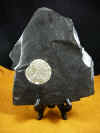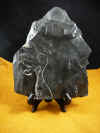|
ANIMAL
ITEMS:
Alaska Carvings & Travels
Alaska
Artifacts
Animal Carvings-Other
Australian
Art
Bronze Works
Bug & Crab Specimens
Exotic Leather Accessories
Gator Items
Gem Animals
Narwhal Tusks
Parasite
Wood Carvings
Safari Animal
Mounts
Sawfish bills
Shark Items
Shark Jaws
Tagua Nut Carvings
Teak Carvings
JEWELRY
ITEMS
Amber Items
Brooches
Cameos
Czech
brooches
Dichroic Glass
Jewelry
Earrings
Eyeglass Holders
Fairy Stone Crosses
Hatpins
Key chains
Maori Fish Hook Necklaces
Music
Jewelry
Necklaces
Opals &, Ivory Items
Pendants
Rings
Titanium
Jewelry
Vintage
Jewelry
FOSSIL ITEMS
Cave Bear Fossils
Dinosaur
Fossils
Mammoth
Fossils
Fossils-Others
Poop Fossils
Poop-Moose & Deer
Fossil Shark Teeth
CLOSEOUT
SALES:
Marbles
Closeout
Sales-Other
ROCK ITEMS
Meteorites
Rocks & Mineral-Other
OTHER COOL
STUFF FOR SALE
Alien Gifts
Boxes boxes
Gemstone
skulls
Indian
Artifacts
Medallions & Coins
Swords,
Daggers, Knives
The Weirdest
Zoo
books & Books
HUMAN
INTEREST
About Us
Cool
Customers
Jesse Nusbaum, Artist
Latest
Travels
2013 Travel America
Newsletter
Support Our Troops
Tina Memorial
Zany & Fun
FOLLOW us on TWITTER for
special DISCOUNTS



| |
You Are On: Rocks & Minerals Page 5
Click To Go To:
Rocks & Minerals Page 1 Page
2 Page 3 Page 4 Page
6 Page 7 Page 8 Page
9
TABLE OF CONTENTS ON PAGE 1
Contents: Pyrite specimens from Peru, Pyrite suns
from Illinois; Desert Roses, Picture Jasper, Septarian Nodule slice Specimens;
Mimetolith links
Natural
PYRITE SUN in ANTHRACITE COAL SHALE MATRIX
Always hard to believe, but
this is the way the pyrite suns naturally form, and then are mined out
of the coal mine in Sparta,
Illinois. This is a high quality, shiny, dense shale found
between the coal seams, in which just the right minerals, pressure,
heat and water combine to grow the pyrite sun as you see here. You
will receive exactly what you see in the photo.
Pyrite suns (also known as
"fool's gold") were thought to be fossilized sand dollars
or lily pads, when in fact they are pyrite crystals formed between layers
of slate and coal, found deep in coal
mines in Sparta (Randolph County), IL, 300 million years ago. A
very difficult cleaning process unveils their hidden natural beauty. As
the Illinois
coal mines shut down one by one, these specimens will become more
and more rare.



This is a close up of the pyrite sun,
and of the back.
You will see drill bit marks in some
of the shale matrix, these are not fossils but drill marks separating the
shale.
Chemistry: Iron
sulfide
Class: Sulfides, Color:
brass yellow; Luster: metallic
Transparence: Opaque;
Fracture: none/conchoidal;
Crystal
system: Isometric; Moh's
hardness: 6-6.5
Locality: Sparta,
Randolph County, Illinois
Individually
priced |

 R541-6
BLUE-GREEN
12-7/8" long x 7-7/8" wide x
1-1/4" thickest
Pyrite sun 3-5/8" diameter
4 lbs 13 oz
|
|
Pyrite Suns
(IRIDESCENT RAINBOW COLORS)
Iridescent pyrite
suns are caused by exposure to chemical gases possibly chlorine which occurs naturally to get the
beautiful iridescent color, making it look like a sun or sun rise.
|
| EXTRA-LARGE
3-1/2 to 4-1/4"
$40 each |

#R-543-120 4-1/4" $38 SOLD |
| Did
you know? That Black Jet, made popular in turquoise jewelry, is
actually a type of fossilized WOOD turned to COAL, formed 180 million years ago from dead
trees? TRUE. |
DESERT ROSES
From Naica, Chihuahua, Mexico. Found in a mine cavern are these glassy gypsum
formations called "selenite". Crystals grow as opaque
sand-filled crystal clusters with mica-like sheets. Clusters can be HUGE
(room-sized) or just single ball rosettes. Under shortwave UV light, they
fluoresce a bright cream color and are moderately phosphorescent, a good
customer named Mike reports. Thanks, Mike! Gotta have one?
|
 |
#R-560
5-1/2 x 3 x 3" tall, large roses, nice display |
$25 |
 |
#R-562
8 x 5 x 4" tall, small roses, beautiful display piece |
$65 |
SEPTARIAN NODULE specimens
Septarian nodules are found 15 miles E of Zion National Park,
Utah. They were formed in an ancient sea floor during the Cretaceous
period, 50-70 million years ago when the Gulf of Mexico extended into
Utah. On the ocean floor, mud formed around decomposed sea life.
Rocking back and forth in the water caused mud balls. When the ocean
receded, the mud balls dried and cracked open.
Over the eons to follow,
mineralized solutions deposited in the cracks. First forming brown
ARAGONITE, then golden CALCITE and occasionally BARITE clusters were formed
within the cavities. The outside of the mud ball is now a gray limestone
rock. As the nodules weathered out of the gray clay hills, at one time
they could be picked up by hand on the surface. Now, excavating equipment
is required for extraction, 20-40 feet underground.
The name "Septarian" is Latin "Septem"
meaning seven. The mud balls cracked with seven points in every direction,
creating a beautiful design. The fossil which started forming the
Septarian nodule is sometimes noticeable in the rock. So, yellow center =
Calcite, Brown lines = Aragonite, Gray rock = Limestone.
One side polished to a
high sheen; these
work well as coasters for the coffee table, or lovely display
pieces
Priced as marked; these
are 1/2" thick slabs
|
| |

#R591-E
3-1/2 x 4-1/2" $27 |

#R591-X
6-1/4
x 8-1/8" $55 |


Awesome fish carving in Septarian nodule material. (seen
front and back). 9 1/2" long x 7 1/2" high. (3 1/4
pounds).
This is Glenn's personal treasure, not for sale.
|
| MIMETOLITHS
Cool Customer Kristal shared photos with
us of his great collection of mimetoliths (a
natural topographic feature, rock outcrop, rock specimen, mineral
specimen, or loose stone the shape of which resembles something
else).
Let your curiosity take you
to searching the net using the word "mimetolith", you will find
some amazing formations, it can be addictive. here's one example:
http://www.cst.cmich.edu/users/dietr1rv/mimetoliths/
My most recent experience would be in the
Kartchner Caves in Arizona, where there were bacon, eggs and angel formations
within the cave which were mind boggling (see Latest Travels, for November
2007 for photos).
Our
neighbor Rebecca came across this tree stump that beavers had gnawed into
what looks like an elephant head. See what you think: 
|
Click To Go To:
Rocks & Minerals Page 1
Page
2 Page 3 Page 4 Page
6 Page 7 Page 8 Page
9 Page 10
Page 11
TABLE OF CONTENTS ON PAGE 1
|